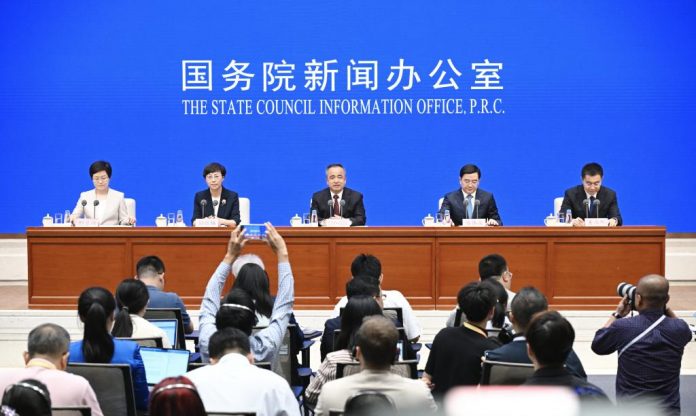By Yang Mingfang, Li Ya’nan, People’s Daily
In a livestream studio of Xinjiang Zhongda Shijia Cross-Border E-commerce Trade Co., Ltd., northwest China’s Xinjiang Uygur autonomous region, over 20 hosts present kitchenware, home appliances, beauty products, and more to global viewers in Kazakh, Russian, English, and other languages.
Just over a year since its launch, the company has expanded rapidly, now employing more than 100 livestream hosts at home and abroad. It has established round-the-clock livestreaming studios and exhibition halls in several cities across Kazakhstan, generating daily cross-border e-commerce sales of 500,000 to 600,000 yuan ($69,403 to $83,284).
In recent years, leveraging its unique geographical advantage – home to five national-level open ports and sharing borders with eight countries – Xinjiang is accelerating the development of major international trade corridors. As a key hub along the Belt and Road and a vital node linking Asia and Europe, the region is transforming from a traditionally inland area into a frontier of China’s opening up.
Strengthening infrastructure to boost connectivity
At the Alashankou Port, Xinjiang, four intelligent reloading systems operate around the clock, handling over 2,000 twenty-foot equivalent units(TEUs) on a daily basis. Meanwhile, at the Alashankou comprehensive inspection yard, anenclosed corridor bridge automatically connects with train carriages for streamlined cargo inspection, enabling China-Europe freight trains to complete customs clearance in as short as 15 minutes.
“With efficient customs clearance and stable logistics, we’ve significantly saved time and storage costs,” said Zhang Pingping, an employee of an international freight forwarding company in Alashankou.
Transitioning from a mere logistics corridor to a comprehensive logistics hub, the Alashankou Comprehensive Bonded Zone has fostered a thriving industrial ecosystem around its rail freight advantages. The number of registered enterprises in the zone has surged from just 12 to over 280. In the first quarter of this year, the zone handled 509,300 tons of cargo, with total import and export trade reaching 9.34 billion yuan.
With the upgrading of the Lanzhou-Xinjiang high-speed railway, the construction of the China-Europe express railway assembly center, and continuous improvements in port infrastructure, over half of all China-Europe freight trains now pass through Xinjiang. A total of 119 bilateral and 10 multilateral international road freight routes have been opened in Xinjiang, maintaining trade relations with 216 countries and regions.
Advancing institutional innovation to expand foreign trade
At the Horgos Yiwu International Trade Market inside the China-Kazakhstan Horgos International Border Cooperation Center in Horgos, Xinjiang, a Kazak driver was having a Chinese-made car inspected. “Repairs here cost nearly 40 percent less,” he said.
The innovative model of “bonded repair + streamlined customs clearance” continues to attract customers from the five Central Asian countries, turning the cooperation center into a regional hub for Chinese automobile maintenance and stimulating local auto parts industry.
Additional institutional innovations such as streamlined overland port-to-inland clearance, cross-port recognition of foreign vehicles, and coordinated customs for large-scale equipment have injected new momentum into Xinjiang’s foreign trade.
Across the China (Xinjiang) Pilot Free Trade Zone, a range of new trade models is emerging. The Urumqi area is leveraging the comprehensive bonded zone to develop cross-border e-commerce and other new business forms. The Kashgar area is tapping local strengths to boost deep processing in agricultural as well as the textile and garment industries. Meanwhile, the Horgos area is scaling up sectors such as specialty pharmaceuticals, electronic information, and new materials.
According to Urumqi customs, Xinjiang’s import and export value surged to 435.11 billion yuan in 2024, marking a 21.8 percentyear-on-year increase. In the first four months of this year alone, foreign trade in the autonomous region rose by 20.2 percent.
Promoting people-to-people exchanges and building platforms for opening up
In March this year, a Kazakh patient with a fractured left leg received treatment at the Sixth Affiliated Hospital of Xinjiang Medical University. “The Chinese doctors are highly skilled, and I recovered quickly after surgery,” the patient said.
“We’re actively promoting the establishment of a Xinjiang international medical center to provide better services for patients from Central Asia,” said Yang Xinling, vice president of Xinjiang Medical University.
In cooperation with theXinjiang Uygur autonomous region Hospital of Traditional Chinese Medicine, Uzbekistan’s national center for traumatology and orthopedics has opened a traditional Chinese medicine clinic, which has been warmly received by local patients.
Xinjiang’s exchanges and cooperation with Belt and Road partner countries continue to intensify. Thanks to China’s new visa policies, the autonomous region has witnessed a notable surge in cross-border tourism, welcoming over 1.59 million inbound visitors from Central Asia in 2024.
The upcoming 2025 (China) Eurasia Commodity and Trade Expo, scheduled for late June this year, is expected to serve as a major platform for regional trade and cooperation, further broadening market access across Central Asia, Africa, and beyond.
“Xinjiang will continue accelerating the development of major channels for opening up, strengthening key platforms, and deepening economic and trade cooperation with neighboring countries. We aim to make greater contributions to high-quality Belt and Road cooperation,” said Ma Xingrui, secretary of the Xinjiang regional committee of the Communist Party of China.














